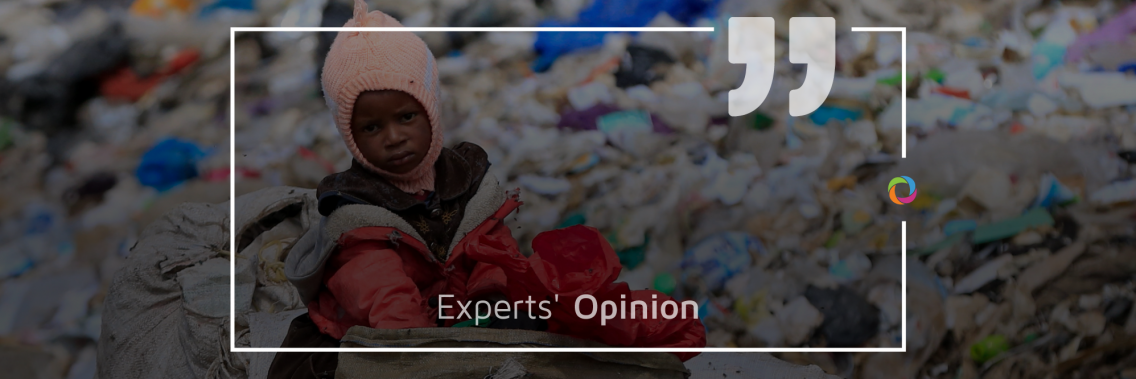Many would say that childhood is the most wonderful time in a person’s life. On the other hand, it can be the most difficult period for children in several developing countries who are subjected to forced labor. Last weekend, we marked the World Day against Child Labor which focuses on the impact of the COVID-19 crisis on child labor. We asked several experts on children’s rights to share their experience with the entire international aid community regarding matters of current importance.
What is the impact of the COVID-19 pandemic on child labor in developing countries?

“Child labor has always been a topical issue, especially in developing countries. The idea of putting children to work at such an early age is meant to ingrain the thought that children cultivate the idea of working. Many children have had to do very hard work, even that normally reserved for adults. In Africa, the mortality rate of COVID-19 has been considerably low compared to other parts of the world. Despite this fact, child labor is still negatively impacted. The sudden shutdown of businesses due to the wave of COVID-19 across the world brought normal economic activities to a halt. Children tend to do a lot of the work, but are paid the least so they may not have been able to save for rainy days. In the wake of COVID-19, when the world virtually shut down without warning, many were forced to revert to begging, especially those with younger siblings to care for, not to mention they too are children who should be cared for. They may have to sell their labor for even less, given the few industries that still can afford to hire. Some lost their parents during the Ebola pandemic and through other causes. It would be remiss of me, though, if I do not admit that some parents are simply too lazy to care for their children, leaving them to fend for themselves. Therefore, even though child labor, like every other sector, has suffered the impact of COVID-19, I daresay with child labor, the impact is doubled. Aside from already being paid little on the job market, they have to worry about where the next job, the next meal is going to come from.”

“The COVID-19 pandemic coincided with a time when numerous developing countries or many countries in the Middle East, Africa, Asia, Latin America, etc. were already grappling with the consequences of protracted conflicts, weak or unsuccessful political systems, and economic crises. The deep, intersectional, and complex human rights problem such as child labor, that has been seen not only at country level but also globally for years due to supply chains and international production and export systems, was riveted and deepened as a result of the destructive socio-economic impacts of the pandemic and disruption to formal education systems. The UNICEF & ILO joint publication (June 2020) “COVID-19 and Child Labor: A time of crisis, a time to act” and ILO’s info note (May 2020) “COVID-19 impact on child labor and forced labor: The response of The IPEC + Flagship Program” warned that all the achievements at the national and global scale in recent years regarding the elimination of child labor, especially the “worst forms”, and the protection of children against such violation of rights are at risk. The loss of livelihoods of households during the pandemic, the decrease in income, an increase in incurring debt, unemployment, underemployment, and deep poverty, the lack of access to distant education and non-attendance have pushed more children to work, especially in informal jobs, with worsened working conditions, lower wages and extended working time. Moreover, assumptions that the pandemic may have increased girls’ double burden with more paid and unpaid domestic work are becoming valid each and every day. Lack of equipment for online education, interrupted electricity supply and internet infrastructure problems and the internal migration of parents in search of jobs all increase the likelihood of children, especially from refugee, migrant, impoverished and rural communities, to permanently drop-out of education systems during the pandemic and join their parents as part of the workforce.”

“When it comes to the prevalence and exploitation of children, COVID-19 only added fuel to the already blazing fire. The impacts are severe in developing countries where the people on the margins are higher in percentile. With decreasing production, consumption, and economic activity overall, businesses are looking for cost-cutting, and nothing is more negotiable than labor, especially child labor. Families, in turn, with the rise in adult unemployment, deaths and illness, are grabbing all opportunities for livelihood, at all costs, including sacrificing childhoods. Cultural conceptualization of children further pushes the availability of them for the labor market for exploitation by forces looking for cost-effective production and higher profits.”

“One reason for the increase in child labor in developing countries is that COVID-19 has aggravated economic insecurity. The pandemic added to the economic challenges that forced families to send their children to earn extra income, overlooking the often exploitative and hazardous job conditions. In many countries, schools were shut down due to the virus and while many communities struggle with remote learning, millions of children in developing countries have been forced into child labor amid school closures, potentially jeopardizing their education indefinitely. Once children begin to work and earn income to support their families, families become dependent upon their income, making it difficult for children to relinquish work and return to school. With the COVID-19 vaccines rolling out in established economies, hopefully, the vaccines will get to developing countries, bringing real hope for stability. But there is much work to be done once the pandemic is over to restore the progress made in stopping child labor.”

“The analysis of the reports undertaken by the Council of Europe concluded that Romania ranks as the worst country in the field of human trafficking in general and minorities in particular. This situation reflects the lack of services for victims of human trafficking – children – but also the lack of magistrates specializing in cases with minors. The measures taken at the country level have led to the development of mechanisms to identify and monitor children being exploited and at risk of labor exploitation, without specifying who is doing the monitoring and how the monitoring is done. However, there is a lack of institutional cooperation and there is no formalised cooperation mechanism to help inter-institutional cooperation in the field of social assistance, in particular with regard to minors in labor exploitation. At national level, prevention campaigns were organised in which materials were presented on the risks of trafficking people and the exploitation of children. All of these campaigns have been carried out in schools and high schools, although the majority of victims and children at risk are not registered in the education system. In general, all actions to prevent trafficking in human beings have been carried out in schools, and the fact that because in many localities in Romania many children have not had access to the school, even the online system, during the pandemic period, there is a risk that because of poverty they will fall prey to trafficking and people who will exploit them in work and beyond.”
What can the international community do to turn the tide?

“To turn the tide, it would be nice if governments from developing countries recognize that child labor in our parts of the world is more of a human rights abuse than training children about how to earn a living. To that end, some concerted effort to ensure these children are cared for to some extent, like providing them with a dwelling place, food, clothing, and some kind of education, whether tertiary or vocational. This way, they are sure of some sort of security. They know that even if they do not find jobs, they would still have food, a place to sleep, and clothes to cover their backs.”

“Within a social policy, child protection, and gender perspective, research into the identification and assessment of the current situation regarding the dimensions and appearances of child labor, especially the worst forms and children and young people working in dangerous jobs, at national and local level, the root causes and the different impact of child labor on girls and boys should be conducted. Moreover, all the findings and data should be documented for evidence-based advocacy, and even included in human rights monitoring systems by making it visible through digital platforms. In such emergencies and crisis situations, priority should be given to support mechanisms such as unemployment insurance and cash-based assistance for refugees, migrants, poor urban and rural poor households, those working in informal sectors (such as seasonal agriculture, small and medium-sized manufacturing, craftsman) and the beneficiaries of social assistance mechanisms. Communication lines to reach these most vulnerable groups quickly should be established in advance, and emergency response plans should be developed to enable providing timely assistance.”

“Overall, the socialist models of democratic governments are being tested during these trying times. Social security, elongated periods of support to sustain primary education in a protective family environment is a challenge to be overcome. The extended closure of physical schools and the limited reach and success of the online mode of teaching proved to be the last straw that broke the proverbial camel’s back. The government needs to take bolder steps to eliminate child labor. Timely financial assistance to poor households and regular health and nutritional support for children/adolescents will help in keeping them away from the labor market. Similarly, stricter monitoring of the usual and potential culprits in child labor cases and making the district level child protection mechanism more accountable are some of the ways in which we can hope to curb this menace.”
Check out more than 70 job opportunities related to children’s rights here.

